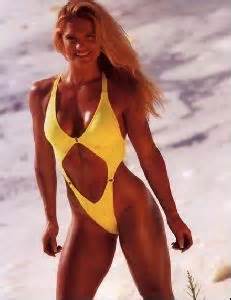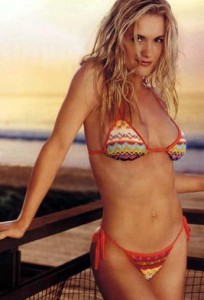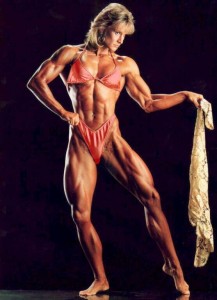HOW THE FIT COVER LADIES GET AND MAINTAIN THEIR LOOK
I have been following natural bodybuilding competitions since I was literally a teenager, back in the late 80’s when the current categories of “figure,” “fitness” and “Pro Bikini” did not exist, nor the “Physique” category. Back then, the categories for women, in this example, amounted to little more than “bodybuilding” or “Olympia.” Cory Everson was a reigning champion for many years in a row back then:
People were indeed fascinated by what seemed to be her genetic gifts, due to having incredible proportions body-wide, but also an ability to reduce her body fat down to minimal levels for contests, and as far as anyone knew, suffer no discernible ill health consequences from it then, nor to this day (in as much as she may maintain a similar lifestyle, which I know for certain she did for many years, including up to and beyond her 50th birthday).
The look was of course “too muscular” by society’s standards, but at the same time was definitely not at the level of her female body builder counterparts. She had distinctly feminine traits, where her female bodybuilder comrades many times may not, and often had a much more dense muscularity than Cory did.
Cory’s look introduced the world to an ultra-toned female body. Again, although perhaps not desirable by the masses of women out there, she nonetheless demonstrated how a woman could, with a certain lifestyle, bring body fat levels down to a minimum that could be maintained to a degree off-season as well, while living a healthy lifestyle.
This soon brought in some new categories to the competition arena, namely that of the “fitness” genre.
The “Fitness” category had its beginnings back in the early 90’s, but never caught on because the women were still considered by the commercial world to just be “too muscular.” Oxygen magazine started up by Robert Kennedy, R.I.P., one of the pioneers in the fitness/bodybuilding world, and introduced through his magazines the female body not so much in a bodybuilding/Olympia form, as a softer “hard body” style that still presented a pronounced muscle tone, but more so than the mainstream was used to.
The look gained a niche fan base, but never broke through more into the standards everyone was accustomed to as being the “optimal female body.”
An example I always remember is Vicky Pratt:
 The picture here shows her in her earlier days, where you can see pronounced muscularity. Not nearly in the realm of the cut-up, see-every-muscle-fiber associated with the female bodybuilders, nor without any of the masculine features often associated with those kinds of competitors.
The picture here shows her in her earlier days, where you can see pronounced muscularity. Not nearly in the realm of the cut-up, see-every-muscle-fiber associated with the female bodybuilders, nor without any of the masculine features often associated with those kinds of competitors.
Instead, she has both muscle tone and perhaps what some would consider just a bit of extra size and muscle shape than might be desirable for women seeking a more Sports Illustrated or of course the runway model, which is a different body type all together.
Vicky altered her name slightly to “Victoria” as she began to change her diet and exercise to alter her body, presenting herself in a new way with her new name. Although most people have never heard of her, she’s actually be quite successful in movies and on TV with the various shows she has worked on.
The picture below shows how the new “Victoria” modified her look as her career developed and opportunities expanded. Again, going back to the industry standard of more “commercial appeal,” Victoria has commented in interviews that she choose to further slim and soften her overall look to help herself be more commercially viable, and you can see the substantial difference between the two body types she has sported:
 Note the softer and less developed biceps/arms, smaller shoulders, less pronounced ab muscles, and skinnier legs. The jobs she was being offered with the larger look above often amounted to the “fantasy” genre of female characters, more suited to super-hero or sword-wielding role play, all of course based on our mass perception of what the female form should be.
Note the softer and less developed biceps/arms, smaller shoulders, less pronounced ab muscles, and skinnier legs. The jobs she was being offered with the larger look above often amounted to the “fantasy” genre of female characters, more suited to super-hero or sword-wielding role play, all of course based on our mass perception of what the female form should be.
The latter look gave her a wider range of roles, and I believe expanded her career options and opened up even more opportunities.
I personally feel this is unfortunate, as I appreciate both looks equally, and wish there was wider acceptance for different body types and looks since they all have their own unique appeal. What most people don’t realize is that when a woman gets noticed, be it in full coverage clothes or in shorts or swimsuits, it is the outline of the muscles on her body, combined with a healthy and higher-than-men-naturally level of body fat, that present what most people consider to be a flattering female form. To this day, muscles on women are under-recognized as being responsible for exactly that effect.*
I studied the difference in workout routines during these transitions back in the day. The more fit/hard body type of look took a lot of work for many of these fitness-type models, usually involving heavier weights and higher number of sets at lower repetitions, not too dissimilar from the way a bodybuilder would work out but without the weight gaining component involved in the diet part of the effort.
The latter look involved a similar but modified muscular demand, making it definitely easier from a workout standpoint but with significant dietary changes to compensate for the lower muscular demands. The great news is that since these earlier days, the science has been finding new and exciting ways to fine-tune these efforts even further, such that less work than ever before can be performed to achieve a very similar look to either, the popular commercial appeal these days seeming to gravitate more and more (I am happy to say) to a look that is a happy medium between the two; one where women can slim down if they wish to, but while accentuating their look and feminine curves through the level of muscle tone they wish to achieve.
*Click for more info on how muscles on women give them their feminine appeal, and provide women with their fat-burning machine on autopilot.
